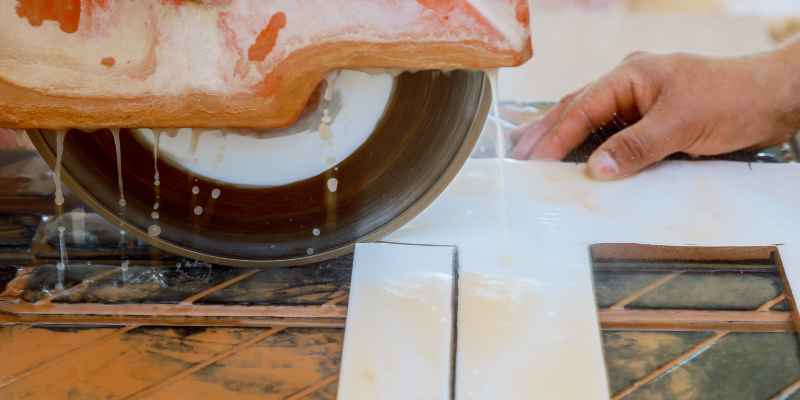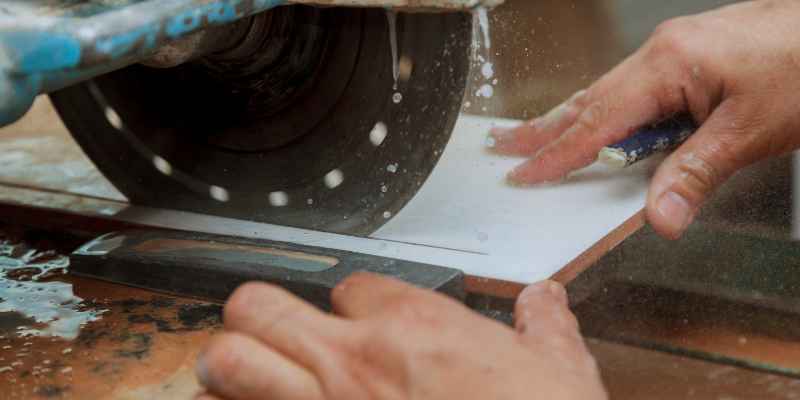To cut tile without a wet saw, use a scoring wheel cutter and snap the tile along the scored line. This method works well for small cuts or thin tiles.
When it comes to DIY tile projects, not everyone has access to a wet saw for cutting. In these cases, using alternative methods like a scoring wheel cutter can be effective. While a wet saw is ideal for large projects or thicker tiles, a scoring wheel cutter is practical for smaller projects or thin tiles.
By following proper techniques and safety precautions, cutting tile without a wet saw can result in clean and accurate cuts, allowing you to complete your project with precision and efficiency.
Using A Manual Tile Cutter
Understanding the Tool: A manual tile cutter is a simple yet effective tool for cutting tiles without the need for a wet saw. It consists of a sharp cutting wheel mounted on a carriage that scores the tile surface.
Techniques For Precise Cuts
- Prepare the Tile: Measure and mark the tile where you want to make the cut using a pencil and ruler.
- Score the Tile: Place the tile on the cutter bed and align the cutting wheel with the marked line. Apply pressure and run the cutting wheel over the tile to score it.
- Make the Cut: Once scored, use the lever or handle of the cutter to apply pressure and snap the tile along the scored line for a clean cut.
- Practice: Practice on scrap tiles to improve your technique and achieve precise cuts.
Understanding The Tool
Handle:
A manual tile cutter consists of a handle used to apply pressure to snap the tile along the scored line.
Cutting Wheel:
The cutting wheel is a sharp tool that scores the surface of the tile to facilitate breaking along the scored line.

Scoring And Snapping Method
Tiling projects can be a great way to update your home or create a stunning new look. However, cutting tiles can be a daunting task, especially if you don’t have access to a wet saw. Thankfully, there is a method called scoring and snapping that allows you to achieve clean and precise cuts without the need for a wet saw. In this article, we will guide you through the step-by-step process of using the scoring and snapping method and highlight the types of tiles suitable for this technique.
Step-by-step Process
- Start by marking the tile where you want to make the cut. Use a pencil or a marker to create a visible line that will serve as a guide during the process.
- Using a tile cutter or a tile scorer, apply moderate pressure along the marked line. Ensure the tool is positioned firmly on the tile surface.
- Drag the scorer across the tile, making a deep and straight groove along the marked line. Apply consistent pressure to achieve a clean scoreline.
- Once the scoring is complete, carefully position the scored line over the edge of a work surface or the edge of a tile. Ensure that the scored line aligns with the surface’s edge.
- Using both hands, apply pressure to the tile on either side of the scored line. This pressure will help the tile snap along the scored line.
- Slowly and firmly press down to snap the tile in two pieces. Ensure controlled pressure to prevent any damage or unevenness.
- After the tile has been snapped, use a tile nipper to remove any remaining small pieces or uneven edges. This step will help you achieve a clean and polished finish.
Types Of Tiles Suitable For This Method
The scoring and snapping method is suitable for various types of tiles, including:
| Type of Tile | Suitability |
|---|---|
| Ceramic Tiles | This method works well for ceramic tiles, providing clean and accurate cuts. |
| Porcelain Tiles | Porcelain tiles can also be cut using the scoring and snapping method, although it may require more pressure due to their hardness. |
| Quarry Tiles | This method is suitable for quarry tiles, allowing you to achieve precise cuts for your project. |
| Glass Tiles | While glass tiles are more fragile, they can still be cut using this method if you apply gentle pressure and use specialized tile nippers for any finishing touches. |
By following the step-by-step process and knowing which types of tiles are suitable for this method, you can confidently tackle your tiling project without a wet saw. Remember to take your time, apply consistent pressure, and always prioritize safety when working with any tools.
Using A Tile Nipper
When it comes to cutting tiles without a wet saw, a tile nipper can be a handy tool for making precise cuts and dealing with small jobs. This method is perfect for cutting small, irregular shapes or for fine-tuning the edges of a tile to fit a specific space.
How Tile Nippers Work
Tile nippers are designed with two carbide jaws that bite into the tile, allowing you to nibble away at the tile to make small adjustments. The jaws act as a cutting mechanism, and by carefully “nipping” the tile, you can shape it according to your needs. However, it’s important to note that tile nippers are most effective for cutting small shapes and notches rather than more substantial cuts.
Tips For Effective Usage
- Score the tile with a straight line using a tile scribe or glass cutter before using the nipper to make a more controlled cut.
- Work slowly and strategically to prevent the tile from breaking unpredictably.
- Use safety goggles to protect your eyes from any flying tile fragments.
Carbide-tipped Scoring Wheel
When it comes to cutting tiles without a wet saw, the carbide-tipped scoring wheel is a valuable tool. This specialized cutting tool allows for precise and clean cuts, making it an essential option for do-it-yourselfers and professionals alike.
Advantages Of Carbide-tipped Wheels
Durable: The carbide-tipped scoring wheel is known for its durability and ability to maintain sharpness over time.
Precision: It offers excellent precision, allowing for smooth and accurate cuts without chipping or wastage.
Versatile: This tool can be used on various tile materials, including ceramic, porcelain, and even some natural stones.
Proper Maintenance For Longevity
Clean after Use: After each use, it’s essential to clean the carbide-tipped scoring wheel to remove any tile residue that may affect its performance.
Storage: Proper storage in a dry and secure place will prevent the scoring wheel from getting damaged or dull.
Regular Inspections: Periodic inspections of the wheel for any signs of wear or damage can help maintain its longevity.
Alternative Tools For Tile Cutting
Discover alternative tools for cutting tile without the need for a wet saw. From manual tile cutters to tile nippers, explore efficient methods for achieving precise tile cuts at home. Upgrade your DIY projects with these innovative tile cutting solutions.
While a wet saw is the most common tool used for cutting tiles, there are alternative tools available that can effectively get the job done. Whether you don’t have access to a wet saw or simply prefer to use a different method, these alternative tools can save you time and effort. Here are two popular options:
Angle Grinder With A Diamond Blade
An angle grinder with a diamond blade is a versatile tool that can be used for various cutting tasks, including cutting tiles. This tool consists of a motor-driven disc and is widely available at hardware stores or online suppliers.
Using an angle grinder with a diamond blade for tile cutting offers several advantages:
- Efficiency: Angle grinders are known for their power and speed, making them ideal for cutting through tough materials like tiles.
- Accuracy: The disc on the angle grinder allows for precise and clean cuts, enabling you to achieve the desired shape or size for your tiles.
- Versatility: Angle grinders can be used for various other tasks in addition to tile cutting, making them a worthwhile investment for any DIY enthusiast or professional.
However, it’s important to note that using an angle grinder requires caution and safety measures. Always wear protective gear, such as goggles and gloves, and pay close attention to the angle and pressure you apply while cutting.
Tile Scribe
A tile scribe is another alternative tool that can be used for tile cutting, particularly for straight cuts or scoring the surface for snapping. This simple and inexpensive tool is commonly used by professionals and DIYers alike.
The benefits of using a tile scribe include:
- Affordability: Tile scribes are budget-friendly and widely accessible, making them an excellent choice for those on a tight budget.
- Precision: Tile scribes create clean and accurate lines, allowing for precise cuts on tiles.
- Portability: Tile scribes are small and lightweight, making them easy to carry around and transport to different work locations.
It’s important to note that while tile scribes are effective for straight cuts, they might not be suitable for more complex or curved cuts. In such cases, an alternative tool like an angle grinder or wet saw may be more appropriate.
Safety Precautions
When cutting tile without a wet saw, safety precautions are crucial to prevent accidents. Always wear protective gear, such as gloves and goggles, to shield yourself from sharp tile fragments. Ensure that the work area is well-ventilated to avoid inhaling dust particles.
Safety precautions are essential when cutting tile without a wet saw to prevent accidents or injurie
Eye Protection
Wear protective goggles to shield eyes from flying tile fragments during cutting.
Gloves And Work Area Preparation
Use heavy-duty gloves to protect your hands. Clear the work area of any obstacles before cutting tile to avoid tripping hazards.

Frequently Asked Questions Of Cutting Tile Without Wet Saw
How Can I Cut Tile Without A Wet Saw?
To cut tile without a wet saw, use a tile nipper for small cuts and a snap cutter for straight lines. Alternatively, a manual tile cutter can be used for larger tiles. These methods provide clean cuts without the need for a wet saw.
What Tools Do I Need To Cut Tile Without A Wet Saw?
You can cut tile without a wet saw using a tile nipper, snap cutter, or manual tile cutter. These tools provide efficient and precise cuts, making them suitable alternatives to a wet saw for DIY tile projects.
Can I Use A Glass Cutter To Cut Tiles?
Yes, a glass cutter can be used to cut ceramic tiles. However, it may not be as efficient as a tile nipper or snap cutter when cutting thicker or larger tiles, but it can still be a viable option for small, intricate tile cuts or mosaics.
What Are The Benefits Of Cutting Tile Without A Wet Saw?
Cutting tile without a wet saw can be quicker, more cost-effective, and doesn’t require water or electricity. It allows for greater portability and ease of use, making it ideal for small tiling projects or for those who prefer not to invest in a wet saw.
Conclusion
Cutting tiles without a wet saw is not only possible but also convenient for small projects or DIY enthusiasts. By using alternative methods such as a snap cutter or an angle grinder equipped with a diamond blade, you can achieve clean and precise cuts without the need for expensive equipment.
However, it is crucial to prioritize safety by wearing protective gear and following proper techniques. With these options, anyone can achieve professional-looking tile cuts without the need for a wet saw.


